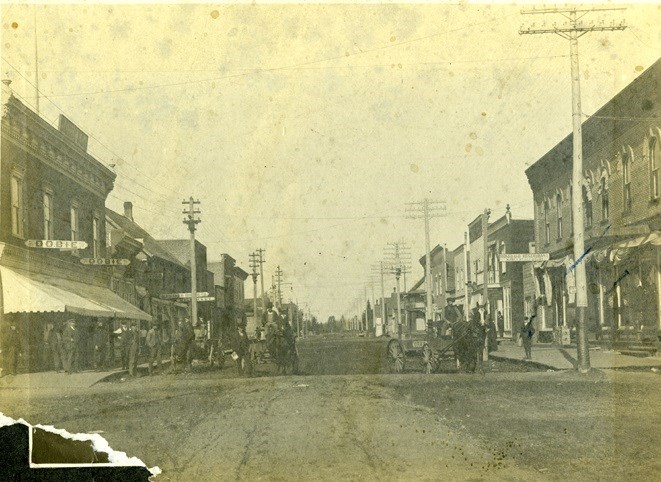From the archives of the Sault Ste. Marie Public Library:
In the late 1800s, a girl by the name of Maud Gillespie went missing.
She was twelve years old, and she lived with her family just outside of Thessalon. She had gone to pick blueberries, and then was going to head into town for music lessons.
She was never seen again.
Her disappearance sparked search parties, all to no avail.
While there were concerns about strange people in town or the possibility that railway workers were involved, the prevailing theory was that Maud had been “kidnapped by Indians” – perhaps a testament to the fraught Indigenous and settler relations at the time.
In his book, Memoirs of a Great Detective, J.W. Murray, who worked the case, weighed in. Born in Edinburgh, Murray immigrated to North America as a child, spending time in the American Navy before beginning his career as a detective.
He worked as a detective on the Canadian Southern Railway before becoming a “government detective officer” and moving to Toronto. Over the course of his detective career, he gained celebrity status and international acclaim, with the Globe claiming him to be the “most famous police official in Canada,” stating that “thousands of people knew him by sight.”
This celebrity detective was brought in to help track down Maud Gillespie. However, his account perhaps spoke more to his opinions of Indigenous people and his love of a good yarn than it did to the facts of the case. He described bartering trout flies and tin foil for information from an Indigenous woman, and searching through the woods for any trace of Maud Gillespie. He spent considerable time describing the beautiful scenery, the good fishing in the area, and how he “lolled by the stream until [his] men came up, and [they] moved on.”
He never found her.
Murray claimed that in 1903, a white woman was discovered by surveyors, “the wife of a big chief.” He described her tanned skin, her broken English, and the way she “possessed a rare beauty of the wilds, yet was not wholly like her associates.”
She apparently remembered her name as being Maud Gillespie and returned home, fifteen years after she first disappeared.
Murray described how she had become “a silent, reserved woman, with the habits and manner and speech of an Indian,” and how “winning her back” was “like taming a wild creature.”
It would have been quite the story – if it were remotely true.
In 1905, shortly after the publication of Murray’s memoirs, Maud Gillespie’s mother spoke with the Sault Daily Star, telling the newspaper that Maud was never found.
The Star was highly critical of Murray and his account, calling his record “unreliable” and saying that there was “something a little unfeeling in Detective Murray’s part in thus making a bogus ‘story’ out of a somewhat recent case in which the relatives of the person most concerned are alive, and acutely interested in anything said or written concerning the matter.”
Disregarding Murray’s account, the actual facts seemed to be that while there had been some speculation that Maud had been found – including an instance in 1903 of a white woman living with Indigenous people north of Superior – nothing had come of it.
The Sault Daily Star proclaimed that it was “probable a young white woman is today held a prisoner by Indians in the Northern Wilds of New Ontario.”
And her mother held out hope that Maud was alive and would be returned home soon.
Detective Murray was rather unhappy with this media attention. He fired back with a letter to the Sault Daily Star in which he fact-checked the family’s claims, calling their version of events inaccurate and saying that he did not think the Star was wise in trusting the family’s story over the official record.
“It is easy to understand that the natural grief of a mother should change her recollection of such a sad event,” he wrote, “and I merely write this letter to correct the facts as published in your own columns.”
Amongst the issues were that the family claimed she went missing in 1890, while Murray claimed it happened in 1888; the family claimed he worked on the case for mere days, while Murray claimed he spent weeks.
While he acknowledged hearing rumours that a woman believed to be Maud Gillespie was found in 1903, he never addressed why this was presented as fact in the book – nor where he got the details about her demeanour and the process of bringing her back into the Gillespie family.
What is known is this: Maud’s father passed away two years after her disappearance, having reportedly suffered insanity from the stress of the events. Her mother remarried and, in 1929, her second husband vanished into the night and committed suicide by drowning. Despite false alarms throughout the years, Maud Gillespie was never found.
In 1967, 77 years after Maud’s disappearance, her sister, who had been a baby at the time of the disappearance gave an interview with the Sault Star about the case. While there was still no trace of Maud, her family never gave up hope.
Each week, the Sault Ste. Marie Public Library and its Archives provides SooToday readers with a glimpse of the city’s past.
Find out more of what the Public Library has to offer at www.ssmpl.ca and look for more Remember This? columns here
